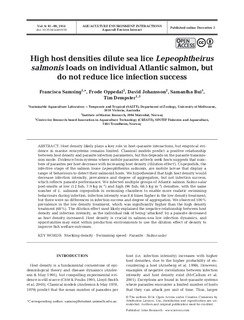| dc.contributor.author | Samsing, Francisca | |
| dc.contributor.author | Oppedal, Frode | |
| dc.contributor.author | Johansson, David | |
| dc.contributor.author | Bui, Samantha | |
| dc.contributor.author | Dempster, Tim | |
| dc.date.accessioned | 2015-01-08T10:02:49Z | |
| dc.date.available | 2015-01-08T10:02:49Z | |
| dc.date.issued | 2014-12-02 | |
| dc.identifier.citation | Samsing F, Oppedal F, Johansson D, Bui S, Dempster T (2014) High host densities dilute sea lice Lepeophtheirus salmonis loads on individual Atlantic salmon, but do not reduce lice infection success. Aquacult Environ Interact 6:81-89 | nb_NO |
| dc.identifier.issn | 1869-215X | |
| dc.identifier.issn | 1869-7534 | |
| dc.identifier.uri | http://hdl.handle.net/11250/273739 | |
| dc.description.abstract | Host density likely plays a key role in host−parasite interactions, but empirical evidence in marine ecosystems remains limited. Classical models predict a positive relationship between host density and parasite infection parameters, but this depends on the parasite transmission mode. Evidence from systems where mobile parasites actively seek hosts suggests that numbers of parasites per host decrease with increasing host density (‘dilution effect’). Copepodids, the infective stage of the salmon louse Lepeophtheirus salmonis, are mobile larvae that display a range of behaviours to detect their salmonid hosts. We hypothesized that high host density would decrease infection intensity, prevalence and degree of aggregation, but not infection success, which reflects parasite performance. We infected multiple groups of Atlantic salmon Salmo salar post-smolts at low (12 fish; 7.9 kg m−3) and high (96 fish; 68.5 kg m−3) densities, with the same number of L. salmonis copepodids in swimming chambers to enable more realistic swimming behaviours during infection. Infection intensity was 8.4 times higher in the low density treatment, but there were no differences in infection success and degree of aggregation. We observed 100% prevalence in the low density treatment, which was significantly higher than the high density treatment (68%). The dilution effect most likely explained the negative relationship between host density and infection intensity, as the individual risk of being ‘attacked’ by a parasite decreased as host density increased. Host density is crucial in salmon−sea lice infection dynamics, and opportunities may exist within production environments to use the dilution effect of density to improve fish welfare outcomes. | nb_NO |
| dc.language.iso | eng | nb_NO |
| dc.publisher | Inter-Research | nb_NO |
| dc.rights | Navngivelse 3.0 Norge | * |
| dc.rights.uri | http://creativecommons.org/licenses/by/3.0/no/ | * |
| dc.title | High host densities dilute sea lice Lepeophtheirus salmonis loads on individual Atlantic salmon, but do not reduce lice infection success | nb_NO |
| dc.type | Journal article | nb_NO |
| dc.type | Peer reviewed | nb_NO |
| dc.subject.nsi | VDP::Agriculture and fishery disciplines: 900::Fisheries science: 920::Fish health: 923 | nb_NO |
| dc.source.pagenumber | 81-89 | nb_NO |
| dc.source.volume | 6 | nb_NO |
| dc.source.journal | Aquaculture environment interactions | nb_NO |
| dc.source.issue | 1 | nb_NO |
| dc.identifier.doi | 10.3354/aei00118 | |

